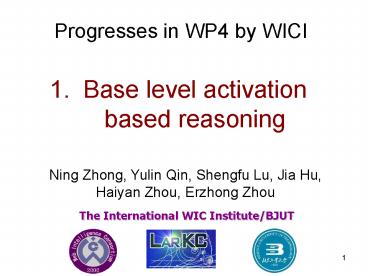Base level activation based reasoning - PowerPoint PPT Presentation
1 / 30
Title:
Base level activation based reasoning
Description:
Heuristic Rules in 4 4 Sudoku. The heuristic rules are simple, clear and easy to use. ... Simplified 4x4 Sudoku (Today) How to learn new heuristic rules? (Future) 19 ... – PowerPoint PPT presentation
Number of Views:45
Avg rating:3.0/5.0
Title: Base level activation based reasoning
1
Base level activation based reasoning
Progresses in WP4 by WICI
Ning Zhong, Yulin Qin, Shengfu Lu, Jia Hu, Haiyan
Zhou, Erzhong Zhou
The International WIC Institute/BJUT
2
ACT-R Meets GrR
- ACT-R, a computational cognitive architecture
based on an information processing modeling of
human brains, is used to analyze our studies and
develop a plugin - The idea of chunk and information organization
structure (multi-level granularity structure) - Spreading activation theory and information
retrieval/selection strategy
3
Activation in ACT-R meets GrR
frequency recency
situation, e.g. task demand
personality, knowledge system, e.g. semantic
context
4
Index Selection List
- Selection based on scalable granules
- Off-line index selection sample
- On-line sample reasoning
5
Basic-level Based Index List
- Simplified equation
- Based on frequency and recency
- Need not to compute and update Bi every time(day,
minute, etc.) - Demo hotel selection
decay parameter
6
Demo Hotel Selection
frequency
7
Demo Hotel Selection
recency
8
9
(No Transcript)
10
(No Transcript)
11
2. Human Heuristic Search in Problem Solving
Progresses in WP4 by WICI
Yulin Qin, Ning Zhong, Haiyan Zhou, Shengfu Lu,
Jie Xiang
The International WIC Institute/BJUT
12
Contents
- Motivation and Goal
- Methodology
- Experiments tentative results
- Discussion Links to LarKC
- Future work
13
Motivation
- LarKC focuses on the huge scale requirement in
the Web and other IT areas caused by the
explosion of information and knowledge (e.g.,
reasoning about 10 billion RDF triples in less
than 100 ms). (Fensel and Harmelen, 2007) - One of the central ideas to overcome this problem
proposed by LarKC is limited rationality,
including heuristic reasoning. (Fensel et al.,
2008) - Human beings have developed sophisticated
heuristic search skills in reasoning, problem
solving and decision making.
Can we be enlightened by human being?
14
Motivation
- heuristic reasoning in the web
Goal
- Neural basis of human heuristic problem solving
- 2. Hints on improving the performance of
searching and reasoning in LarKC.
15
Methodology
fMRI
- fMRI experiments
- fMRI data analysis
- Confirmation analysis, in which the major ROIs
(Regions of Interests) were found by ACT-R group. - Exploratory analysis, in which the ROIs will be
defined based on the activations. - Multi-Voxel Pattern Analysis, Extracting the
activation patterns of each voxel . - Modeling
- An ACT-R model will be built to
predict/simulate the behavior data and the BOLD
effect of fMRI in selected ROIs.
16
Paradigm Simplified 4 x 4 Sudoku
4 x 4 Sudoku
- It is simple (good for fMRI)
- It is still a problem (involving all aspects of
problem solving)
Start State
Goal State
17
Heuristic Rules in 4 4 Sudoku
Simple
Complex
The heuristic rules are simple, clear and easy to
use.
18
- How to apply a heuristic rule?
- How to find an appropriate heuristic rule?
- gt Simplified 4x4 Sudoku
- (Today)
- How to learn new heuristic rules?
- (Future)
19
Study 1 The Retrieval and Application of
Heuristic Rules
- 22 event-related parametric designed fMRI
experiment - Steps needed to solve the problem, 1-step vs.
2-steps. - Difficulty to solve the problem, simple vs.
complex.
a. 1-step simple b. 1-step complex c.
2-step simple d. 2-step complex
20
Study 1 Experiment Procedure
- Training
- Training participants to get familiar with the
heuristic rules - Scanning
- Participants were encouraged to finish the
problem as correctly and quickly as possible. - Both behavioral data and BOLD signals were
recorded and analyzed.
The procedure of a trial.
21
Study 1 Results Behavior Data
22
Study 1 Results fMRI Exploratory Analysis
23
Study 1 Results fMRI Multi-Voxel Pattern
Analysis
- Extracting the activation patterns of each voxel
to get more information to explore the mechanism
of applying heuristic rules.
24
Clustering Activation Pattern
- Brain areas of different activation patterns
25
Study 2 The Selection of Heuristic
- 22 event-related parametric designed fMRI
experiment - Task type, with question mark vs. without
question mark (anchored or non-anchored). - Difficulty to solve the problem, simple vs.
complex.
2
?
3
1
2
3
1
?
2
4
2
3
2
3
4
1
4
1
4
2
a. Anchored simple
- Anchored
- complex
c. Non-anchored simple
d. Non-anchored complex
26
Study 2 Experiment procedure
- Training
- Training participants to get familiar with data
glove - Training participants to get familiar with the
heuristic rules - Training participants to get familiar with
responding system - Scanning
Time
Max 20
2
s
2
s
s
2
s
10
s
2
2
3
3
4
1
1
1
1
Response
Stimulus
Feedback
Trail Start
Rest (ITI)
27
Study 2 Results Behavior Data
28
Discussion and Links to LarKC
- Study 1 suggested that using heuristic rules,
even very simple, might involve the activation of
vast brain areas related to goal control, problem
state representation, memory retrieval and so on.
- gt Heuristic search seems involving complex
information processing processes that requires
good organization of the heuristics and the
appropriate way to use heuristics. - Study 2 showed that the mean Reaction Time and
Accuracy of anchored task were better than that
of no-anchored task. - gt It seems that cues provided before reasoning
can improve reasoning performance, such as
reasoning speed and accuracy - Only tentative results, needs much more work.
29
Future Work
- Modeling heuristic problem solving based on ACT-R
to reveal the dynamic characteristics of the
information processing in heuristic problem
solving. - How to form new heuristic rules?
- Hints to LarKC ?
30
Thank You !































